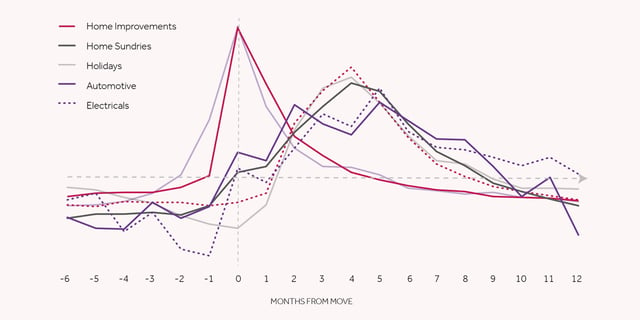Homemovers' spending power stretches far beyond their move date
For a recent article featured in Internet Retailing, our Planning Director, Danny Crowe, discussed the increased spending power of homemovers - even beyond their move date. To read the full article, click here.
Retailers won’t survive if they are not investing in relevant customer interaction. Understanding customers and prospects, what they are doing and why they are doing it – so we can respond appropriately – has never been more important as a means to build firmer customer relationships.
Consumer insight & personalisation for retail marketing
Research recently revealed by Cognizant showed that UK shoppers can become indifferent to retailers if they receive irrelevant offers from them. Only 38% believe that retailers actually use their data effectively, while 51% say that the offers they receive do not offer value and 56% claiming the products are not relevant.
Retail marketers instinctively know that acting on consumer insight is essential, with many rightly obsessed with finding patterns of consumer behaviour to help inform and implement personalised marketing campaigns. This kind of analysis makes it possible to put customers and prospects into specific segments so they can then receive appropriate communications. This is a good first move and yet it lacks one essential element – context.
Life stage triggers for personalisation
One of the best ways businesses can add context to their customer knowledge is to use life event data. Whether it is moving home, having a baby, going to university or retiring, all of these events have a massive impact on consumers’ lives – and on their purchasing behaviour too. Factual life event data is far more powerful than inferred data that is more commonly used in marketing as it enables brands to truly understand the motivations driving consumer activity rather than having to make assumptions.
Bringing context into marketing decision-making brings a new spin to CRM. Instead of Customer Relationship Marketing, a better definition in today’s data-rich, always-on and connected world is ‘Conversations that are Relevant and Measurable’. By understanding the motivation behind the behaviour, brands can move beyond tactical offers to deeper ongoing relationships where communications are not just about eliciting sales, but about giving consumers what they need according to a bigger picture of their life events. It’s looking beyond one transaction or online search and playing a longer game.
Personalised marketing success with homemovers
The opportunities that this approach offers retailers can be seen very clearly within the homemover market. It typically takes at least 18 months from start to finish for people to move, including 12 months post move when the main home improvement spend occurs. So identifying people during the homemover process offers the chance to reach people at a time when they are likely to make many more major purchases compared to normal. The purchasing power of homemovers equates to £12 billion annually across the UK – with those purchases being typically spread across at least 12 months.
In the graph below, we have mapped data from a number of major brands against our homemover database of 99.6% of all UK house movers – giving them insight into the relationship between customer behaviour and the homemover process. These Homemover Waves show when purchasing dips and spikes across several industry sectors as homemovers shift from putting their house on the market, through to moving in and beyond. So, for example, we know that furniture buying actually kicks in before people move, DIY happens at the point of moving in, electrical goods are bought a month or more afterwards and, presumably following the stress of the move, holidays become a big purchase between two to six months post-move.

For the retailers who have mapped their own data against our homemover data, this insight has proven invaluable. For a start, they can identify what proportion of their customers are homemovers. For some brands the proportion can be massive – with, for example, 20% of bed buyers and 35% of consumer electrical buyers being homemovers. By understanding the size of the opportunity that homemovers provides them they can allocate budget accordingly.
The next step is to then track their database against homemover data so that they can identify which of their customers are moving at any given time, and then send them communications that are relevant to where they are in the homemoving process.
Homemover data can be used across a wide variety of digital and traditional marketing channels including direct mail, email, programmatic advertising and social media, so brands can reach homemovers not only with the right message at the right time, but using the right channel.
In our experience homemovers consistently outperform other retail consumers, remaining at the top of the pile for at least 12 months. So why aren’t all retailers creating homemover marketing strategies yet? One of the biggest barriers is the fact that they are not sure who should own the activity – Digital? CRM? Marketing? – making it difficult to secure budget. However, for those retailers who have woken up to the opportunity, it is often viewed as their secret weapon – an untapped opportunity that, once turned on, keeps flowing. As marketing teams increasingly shift towards ecommerce and digital channels, though, more retailers are likely to wake up to the power of the Homemover Wave.
To read the full article, click here, or to find out more about how TwentyCi can help with your homemover targeting campaign, read our latest case studies. Get in touch to talk to our professionals.